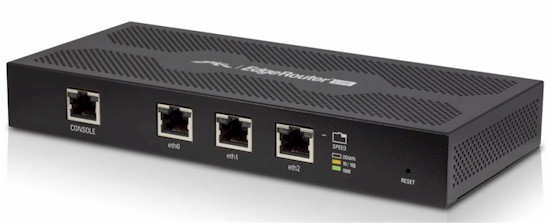
Read on SmallNetBuilder

Just a comment to add to the 'Not for Networking Newbies' warning. I'm a long time IT professional, although not on the networking side. So, when i read the first review I, admittedly, took the warning with a bit of a grain of salt. I figured I could muddle through.
i wouldnt call it hi performance, and i dont bother with the stock features either. Before i mentioned elsewhere that i have both the ERPRO and CCR1036.
Also regarding the certificate issue, you can however circumvent it in the edgerouter by diving into the linux bit and skipping the GUI altogether. He is right about the community, both mikrotik and ubiquiti communities have their elitists, and i do enjoy irritating their elitists (with mikrotik simply mention torrent client, xsane, cups,..), with ubiquiti its their real lack of performance when not using hardware acceleration.
Big warning message about the router configuration page being unsafe. Yes, you can push through, but you do feel very uncomfortable doing so? How can a router manufacturer profess to be top quality when they don't even bother to fix a certificate issue.
The platform is already out in public beta and called EdgeRouter-4 (no lite).Quite a timely update, as I believe there is an updated version of the ER-Lite coming Real Soon Now™. Rumoured to have performance 50% greater than the ER-Pro (which is already quite a bit faster than the ER-Lite).
Network professional is stretching it man, I think someone who can read and is semi-technical is all that is required.The platform is already out in public beta and called EdgeRouter-4 (no lite).
The major upgrades are a routed SFP port and change of the CPU from 2 cores at 500mhz to 4 cores at 1ghz.
As for the difficulty of the platform, I can only speak for myself. This is not a system for the average user. It is hardware and software catering to small ISPs and for anything other than basic config requires a networking professional to get working. For myself it has been a joy and pleasure to use but would never subject my parents to setting one up like a Netgear or Asus.
As for the difficulty of the platform, I can only speak for myself. This is not a system for the average user. It is hardware and software catering to small ISPs and for anything other than basic config requires a networking professional to get working. For myself it has been a joy and pleasure to use but would never subject my parents to setting one up like a Netgear or Asus.
Well, my experience started to slide from the first attempt to configure. Big warning message about the router configuration page being unsafe. Yes, you can push through, but you do feel very uncomfortable doing so? How can a router manufacturer profess to be top quality when they don't even bother to fix a certificate issue. If you question this in the user community you are met with snide remarks about not being worthy of owning the device. Or, a bunch of mumbo jumbo about creating your won certificate server. What the heck? For a $90 SOHO router I'm going to create a certificate server? What are they drinking.

Welcome To SNBForums
SNBForums is a community for anyone who wants to learn about or discuss the latest in wireless routers, network storage and the ins and outs of building and maintaining a small network.
If you'd like to post a question, simply register and have at it!
While you're at it, please check out SmallNetBuilder for product reviews and our famous Router Charts, Ranker and plenty more!
